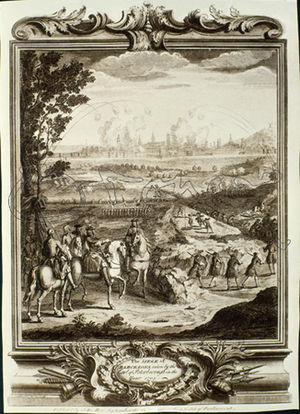
The Battle of Almansa took place on 25 April 1707, during the War of the Spanish Succession. It was fought between an army loyal to Philip V of Spain, Bourbon claimant to the Spanish throne, and one supporting his Habsburg rival, Archduke Charles of Austria. The result was a decisive Bourbon victory that reclaimed most of eastern Spain for Philip.
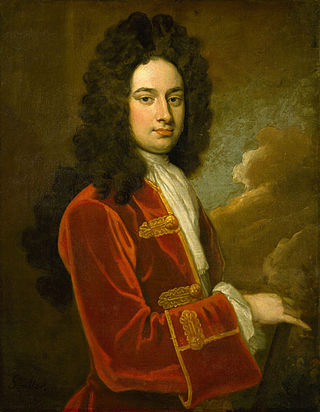
James Stanhope, 1st Earl Stanhope was a British soldier, diplomat and statesman who effectively served as Chief Minister between 1717 and 1721. He is also the last Chancellor of the Exchequer to sit in the House of Lords.
The Battle of Brihuega took place on 8 December 1710 in the War of the Spanish Succession, during the allied retreat from Madrid to Barcelona. The British rearguard under Lord Stanhope was cut off within the town of Brihuega and overwhelmed by a Franco-Spanish army under the duc de Vendôme. Brihuega with other events brought an end to the British participation in the war.
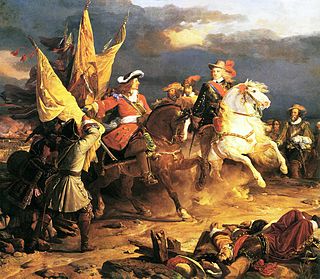
The Battle of Villaviciosa was a battle between a Franco-Spanish army led by Louis Joseph, Duke of Vendôme and Philip V of Spain and a Habsburg-allied army commanded by Austrian Guido Starhemberg. The battle took place during the War of the Spanish Succession, one day after a Franco-Spanish victory at Brihuega against the British army under James Stanhope. Both Philip V of Spain and the Archduke Charles of Austria claimed victory, but the number of dead and wounded, the number of artillery and other weapons abandoned by the Allied army and the battle's strategic consequences for the war confirmed victory for Philip.

The Battle of Saragossa, also known as the Battle of Zaragoza, took place on 20 August 1710 during the War of the Spanish Succession. A Spanish Bourbon army loyal to Philip V of Spain and commanded by the Marquis de Bay was defeated by a Grand Alliance force under Guido Starhemberg.
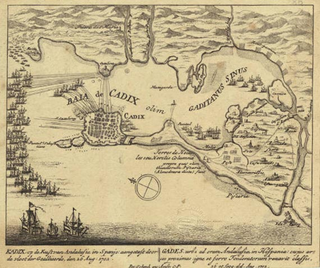
The Battle of Cádiz, fought in August/September 1702, was an Anglo-Dutch attempt to seize the southern Spanish port of Cádiz during the War of the Spanish Succession. The Andalusian city of Cádiz was the great European centre of the Spanish–American trade. The port's capture would not only help to sever Spain's links with her empire in the Americas, but it would also provide the Allies with a strategically important base from which the Anglo-Dutch fleets could control the western Mediterranean Sea.

The siege of Toulon took place between 29 July to 21 August 1707 during the War of the Spanish Succession, when a combined Savoyard-Imperial army supported by a British naval force, attacked the French base at Toulon.
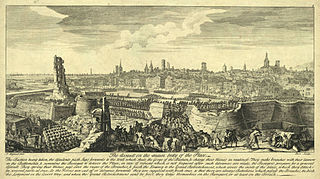
The siege of Barcelona was a thirteen month battle at the end of the War of Spanish Succession, which pitted Archduke Charles of Austria against Philip V of Spain, backed by France in a contest for the Spanish crown.

Prince George Louis of Hessen-Darmstadt was a Field Marshal in the Austrian army. He is known for his career in Habsburg Spain, as Viceroy of Catalonia (1698–1701), head of the Austrian army in the War of the Spanish Succession (1701–1705) and governor of Gibraltar in 1704. He was killed during the Siege of Barcelona the following year. He was known in Spanish as Jorge de Darmstadt and in Catalan as Jordi Darmstadt.
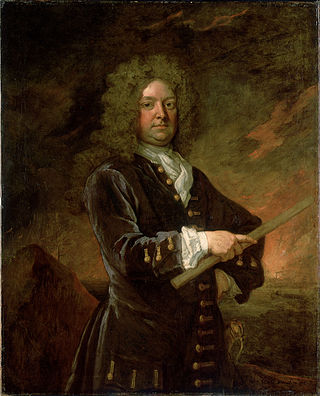
Admiral of the Fleet Sir John Leake was a Royal Navy officer and politician. As a junior officer he saw action at the Battle of Texel during the Third Anglo-Dutch War. He then distinguished himself when he led the convoy that broke the barricading boom at Culmore Fort thereby lifting the siege of Derry during the Williamite War in Ireland. As a captain he saw action in some of the heaviest fighting at the Battle of Barfleur and was also involved in a successful attack on the French ships at the Battle of La Hogue during the Nine Years' War.

Rafael Casanova i Comes was a Catalan jurist and supporter of Charles VI, Holy Roman Emperor as a claimant to the Crown of Spain during the War of the Spanish succession. He became mayor of Barcelona and commander in chief of Catalonia during the Siege of Barcelona until he was wounded in combat while commanding La Coronela during the counterattack on the Saint Peter front on the last day of the siege, 11 September 1714. After the war he received a royal pardon for having supported the Habsburg claim to the Spanish throne. He recovered from his wounds, and continued his fight against absolute monarchy as a lawyer. It has been claimed that he is the author of the book Record de l'Aliança fet el Sereníssim Jordi Augusto Rey de la Gran Bretanya in which Catalonia reminds England of the Treaty of Genoa and their obligation to Catalonia.

The siege of Lille was the salient operation of the 1708 campaign season during the War of the Spanish Succession. After an obstinate defence of 120 days, the French garrison surrendered the city and citadel of Lille, commanded by Marshal Boufflers, to the forces of the Duke of Marlborough and Prince Eugene.

The Capture of Gibraltar by Anglo-Dutch forces of the Grand Alliance occurred between 1 and 4 August 1704 during the War of the Spanish Succession. Since the beginning of the war the Alliance had been looking for a harbour in the Iberian Peninsula to control the Strait of Gibraltar and facilitate naval operations against the French fleet in the western Mediterranean Sea. An attempt to seize Cádiz had ended in failure in September 1702, but following the Alliance fleet's successful raid in Vigo Bay in October that year, the combined fleets of the 'Maritime Powers', the Netherlands and England, had emerged as the dominant naval force in the region. This strength helped persuade King Peter II of Portugal to sever his alliance with France and Bourbon-controlled Spain, and ally himself with the Grand Alliance in 1703 as the Alliance fleets could campaign in the Mediterranean using access to the port of Lisbon and conduct operations in support of the Austrian Habsburg candidate to the Spanish throne, the Archduke Charles, known to his supporters as Charles III of Spain.

The Battle of Montjuïc took place between 13 and 17 September 1705 during the War of the Spanish Succession.

Colonel Mitford Crowe was an English diplomat, merchant, politician and colonial administrator who sat in the Parliament of England from 1701 to 1702 and served as the governor of Barbados from 1707 to 1710. He is best known for his career during the War of the Spanish Succession, where Crowe negotiated the Pact of Genoa with the Principality of Catalonia, which brought them into the Grand Alliance.

The Landing at Barcelona was a failed Allied attempt in May 1704 during the War of the Spanish Succession to capture the city of Barcelona from its Spanish pro-Bourbon defenders.
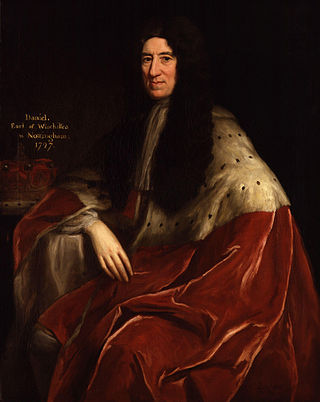
No Peace Without Spain was a popular British political slogan of the early eighteenth century. It referred to the ongoing War of the Spanish Succession (1701–1714) in which Britain was a leading participant. It implied that no peace treaty could be agreed with Britain's principal enemy Louis XIV of France that allowed Philip, the French candidate, to retain the Spanish crown. The term became a rallying cry for opposition to the Tory government of Robert Harley, Earl of Oxford and the terms of the Treaty of Utrecht.
John Richards (1669–1709) was an Irish soldier and artillery commander. He served in the Portuguese Army during the War of the Spanish Succession and was killed when a mine was detonated by the enemy while in command of the defence at the Siege of Alicante.
The siege of Alicante took place from December 1708 to April 1709 during the War of the Spanish Succession. The city of Alicante was besieged by a French and Spanish force loyal to Philip V. They were opposed by the garrison, an Allied force under the command of John Richards.
Lewis Petit des Etans was a French-born military engineer and brigadier-general in the British Army.
